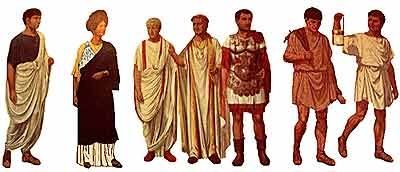By Michael Anderson.

At its beginning, Rome was a group of egalitarian tribes living in proximity to each other on the hills surrounding a swamp that would become the Forum. Over time, the population grew steadily as new groups became affiliated, but the three original tribes, Ramnes, Tities, and Luceres, stood out as leaders and assumed a position of power over the other groups. They called themselves patricians and gave the name plebian to the other tribes made up of “common” people.
During the first hundred years of Rome, a status structure evolved into a class structure and then a political system. Those patricians with money or influence rose to the top — one of them became king, while the others acted as advisors through their membership in the Senate. The latter numbered three hundred, one third from each of the three original tribes. The city was divided into voting districts called curia and citizens from these districts were allowed to participate in an assembly, which could pass legislation and elect magistrates. This structure was controlled by the monarchy for about two centuries until 509 B.C, when the king was overthrown and Rome became a Republic. The powers of the king were now divided among three men: two consuls and the Pontifex Maximus. The consuls served as chief magistrates of the Republic and served in office for one year. Each had veto rights over the other to prevent a dangerous accumulation of power. The Pontifex was the religious leader, tasked with predicting the future and making sure the gods were appeased at all times.
Beneath the political system, an informal system of patrons and clients operated as a shadow class. Patrons protected the interests of their clients, while the clients did favors for their patrons. Favors varied: run a business, organize a group for a specific purpose, or assault a person who had offended the patron were typical examples. Clients were compensated with money or helped with their careers and those plebs who were highly motivated could become wealthy with the help of their patron. Patrons benefitted from the relationship by expanding their authority through the recruitment of new clients who would be loyal to them. This system worked because it benefited both sides and helped appease the interests of those who sought upward mobility. As time went on, a middle class was built by the work of plebeians who became successful at business – merchants, manufacturers, shippers, money lenders, etc.
From the very beginning of the Republic, there was a conflict of classes – patrician against plebeian. As early as the 490s B.C, the plebs called a general strike to demand additional rights. The granting of these rights was stretched out over two hundred years by a reluctant Senate, although the slow pace helped keep the Republic stable over that period.
Early protests led to the creation of the tribunate in 494 B.C. (Lex Sacrata) — the first magistracy representing the common people. Ten tribunes were elected for the term of one year with the right to physically and legally protect the plebs from harm caused by the upper class. The next important concession dealt with the publishing of laws, which had been previously kept secret by the upper class. In 449 B.C, the Twelve Tablets were displayed in the Forum as the first published list of rights that applied to all the Roman people.
Over the next hundred and sixty years, the class struggle was focused on the people’s right to office and their right to make laws. The magistracies in the Republic included tribunes, aediles (managers of public property), questors (treasurers), praetors (judges), censors, and consuls (senior magistrates), and, one by one, these were opened up to the common people. In 367 B.C, one consul was designated for a candidate from the lower class, with censor in 339 B.C and the praetor in 337 following. The watershed event on the legislative side was the passage of Lex Hortensia in 287 B.C. which granted the Concilium Plebis (people’s assembly) the right to pass laws binding on both patricians and plebeians. At last the plebs had reached something close to political parity with the upper class.
The great sociologist Max Weber used three social categories to describe man’s place in society — status, class, and the power which flows for from them. Furthermore he described three types of class division: propertied, commercial, and social. A propertied class, as you can imagine, is defined solely by ownership of property. A commercial class is defined by one’s success in business as driven by markets. A social class is one with one with mobility that allows the individual free movement upward.
At the foundation of Rome, the patricians had status based on their control of government, they sat at the top of the propertied class, and they were able to exert power based on their monopoly of government administration and secretive control of the legal system. They did not pursue success in a commercial class (except by proxy) because of their hatred of business. The knights (Equites, or middle class) were originally given status by the monarchy as cavalry in the Roman Army because they had the financial assets to purchase equipment, including horses. Later they rose to the top of the commercial class because they were successful in business and as government bureaucrats. Commercial success allowed them to acquire land and achieve property status. The growing influence of the knights, coupled with the erosion of patrician control over government office and the making of laws, eventually took away patrician power and distributed it among the other classes.
Oddly, it was the patricians (Sulla and Caesar) who paved the way for the destruction of the Republic. Using their patrician titles as a basis for moral authority, they put power above tradition by introducing the new element of military authority. Control of the army would trump status and class to drive the Republic toward an empire.


